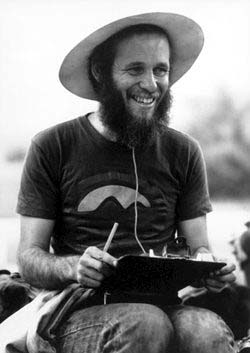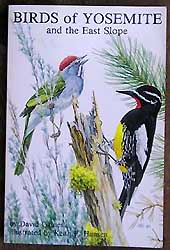 David
Gaines was the most important environmentalist to come from the ranks of
the hardcore California birders. Although it is probably too simplistic
to say that David Gaines saved Mono Lake, it is close enough to the truth
to warrant consideration. David's death in a tragic auto accident in January
1988 saddened all of the California bird world, and in some respects provides
an end-point to a simpler, more carefree era. David
Gaines was the most important environmentalist to come from the ranks of
the hardcore California birders. Although it is probably too simplistic
to say that David Gaines saved Mono Lake, it is close enough to the truth
to warrant consideration. David's death in a tragic auto accident in January
1988 saddened all of the California bird world, and in some respects provides
an end-point to a simpler, more carefree era.
Long before he became famous as a spokesman for the environment, David was an active California birder. He was birding the entire State by the late '60s, first appearing in the southern California pages of Audubon Field Notes in winter 1966-67, and in those for northern California in fall 1967. I believe that David grew up in the Los Angeles area, and I know that he joined by Los Angeles Audubon Society in the early 1970s where he birded locally with Keith Axelson, Gilbert King, and Arnold Small. He then went to Stanford University for college. He was very much a part of the active State birders seeking out vagrants in desert oases in the early 1970s, and also became friends with the "PRBO crowd," including Rich Stallcup. Among the projects that interested him were studies of declining bird populations, and he undertook surveys of the riparian breeders in the Sacramento Valley, leading to a significant publication (Gaines 1974) In 1974, David inventoried the natural areas of the Mono Basin. The following year "he joined fellow students at Stanford in writing and receiving a grant from the National Science Foundation to conduct the first comprehensive ecological survey of Mono Lake. Their report was published in 1977 by the UC Davis Institute of Ecology. Among the report's main findings was the fact that water diversions from the lake's tributary streams by the Los Angeles Department of Water and Power (LADWP) was a threat to the lake's ecosystems. The diversions had begun in 1941, and had already caused the lake to lose half of its volume and double in salinity. The diversions also caused the lake's Negit Island to become connected to the mainland, allowing predators access to an essential California Gull rookery;" [quotes from "Saving Mono Lake" by Shelly Biswell, Sierra Citizen, spring 2002 issue]. David would join David Winkler (the editor of the UC Davis report) and Sally Judy (whom he would later marry) to form the Mono Lake Committee (MLC) in 1978. This grassroots group was able to conduct the research and enlist public opinion to save Mono Lake. The MLC joined with National Audubon Society to bring suit to save the lake, and in 1983 the California Supreme Court agreed that the "public trust doctrine" required LADWP to limit water diversions. It was not until 1994 — some 20 years after David Gaines had first become interested in Mono Lake — that the State set minimum flow limits on streams running into the lake, mandated a minimum lake level, and required habitat restoration. By then, alas, David had died. |
|
 |
|

To focus entirely on Mono Lake, however, is to overlook many of David's other attributes and achievements. He was a superior field observer, and his interests in California birdlife extended well beyond the Mono Basin (e.g., co-authored paper on the decline in California of Yellow-billed Cuckoo [Gaines & Laymon 1984] and Least Bell's Vireo [Goldwasser et al. 1980]). He authored a checklist to Yolo County (Gaines & Beedy 1987). Most of all, David loved Yosemite National Park, and published two classic books on the birds of Yosemite (Gaines 1977, 1988; the latter [cover shown at right; the exceptional cover art is by Keith Hanson] also covered the Mono Basin in detail, although both texts covered both slopes of the Yosemite Sierra). David was also a teacher, a mentor, a musician, and a poet. In an era when bird distribution texts were written in dry, scientific language (including my own), David's texts were enlivened with his spirit and appreciation for all of nature. While someone else's summary of, say, the distribution of Mountain Bluebird might begin "Mountain Bluebird is a fairly common summer breeder in dry, open meadows at high elevations,: David's text (in Gaines 1988) begins this way:
|
|
Selected publications 1974-1989:
|